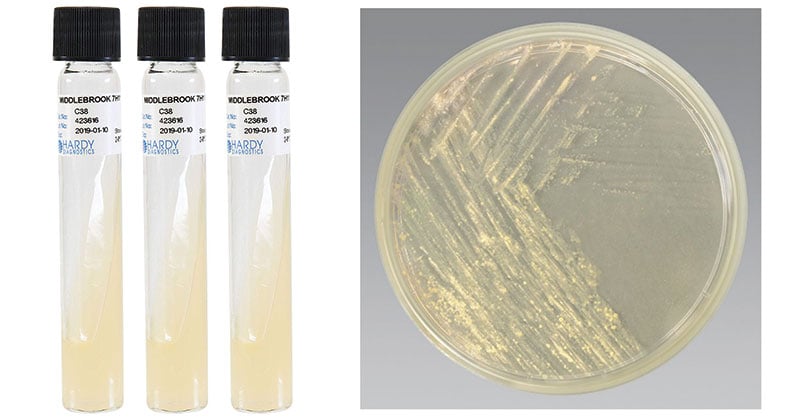There are many culture media that have been devised for the cultivation of mycobacteria over the years. The early ones were egg-based formulations which included Lowenstein-Jensen Medium and Petragnani Medium. Later, Dubos and Middlebrook developed various formulations containing oleic acid and albumin as key ingredients, which protect Mycobacterium from toxic agents, helping for the growth of tubercle bacilli. Subsequently, Middlebrook and Cohn improved the formulation of oleic acid-albumin agar and obtained faster, more luxuriant growth of Mycobacterium species. Middlebrook 7H10 Agar Base was formulated as per Middlebrook, Cohn et al reformed the original oleic acid-albumin agar and observed rapid and luxuriant growth of Mycobacterium species. Middlebrook 7H10 Agar Base is also used for isolation, cultivation, and sensitivity testing of M. tuberculosis on enrichment with OADC Growth Supplement and glycerol. It has been reported that the 7H10 medium tends to grow fewer contaminants than the egg-based media commonly used for the cultivation of mycobacteria.

Image Source: Fisher Scientific
Interesting Science Videos
Composition of Middlebrook Agar
Middlebrook 7H10 Agar Per 900 mL
| Ammonium Sulfate | 0.5 g |
| Monopotassium Phosphate | 1.5 g |
| Disodium Phosphate | 1.5 g |
| Sodium Citrate | 0.4 g |
| Magnesium Sulfate | 25.0 mg |
| Calcium Chloride | 0.5 mg |
| Zinc Sulfate | 1.0 mg |
| Copper Sulfate | 1.0 mg |
| L-Glutamic Acid (sodium salt) | 0.5 g |
| Ferric Ammonium Citrate | 0.04 g |
| Pyridoxine Hydrochloride | 1.0 mg |
| Biotin | 0.5 mg |
| Malachite Green | 250.0 µg |
| Agar | 15.0 g |
pH 6.6 +/- 0.2 at 25ºC.
Middlebrook OADC Enrichment
| Ingredients | Gm/L |
| Sodium Chloride | 8.5 g |
| Dextrose | 20.0 g |
| Bovine Albumin (Fraction V) | 50.0 g |
| Catalase. | 0.03 g |
| Oleic Acid | 0.6 mL |
Principle of Middlebrook Agar
Middlebrook Agar contains a variety of inorganic salts that provide substances essential for the growth of mycobacteria. The component sodium citrate, when converted to citric acid, serves to hold certain inorganic cations in solution. Glycerol is an abundant source of carbon and energy. In the enriched medium, sodium chloride provides essential electrolytes and maintains osmotic equilibrium. The oleic acid, as well as other long-chain fatty acids, can be utilized by tubercle bacilli and plays an important role in the metabolism of mycobacteria. The albumin in the media aid in the protection of the tubercle bacilli against toxic agents hence, it enhances their recovery on primary isolation. Dextrose is the fermentable carbohydrate and an energy source whereas catalase destroys toxic peroxides that may be present in the medium. Partial inhibition of bacteria is achieved by the presence of the malachite green dye.
Preparation of Middlebrook Agar
- Suspend 19 g of the powder in 900 mL of purified water containing 5 mL of glycerol.
- Mix thoroughly.
- Heat with frequent agitation and boil for 1 minute to completely dissolve the powder.
- Autoclave at 121°C for 10 minutes.
- Aseptically add 100 mL of Middlebrook OADC Enrichment to the medium when cooled to 50-55°C.
- Pour into the sterile tubes.
Results and Interpretation on Middlebrook Agar
- Cultures should be read within 5-7 days after inoculation and once a week thereafter for up to 8 weeks.
- For reading plates or bottles, invert the containers on the stage of a dissecting microscope.
- Read at 10-60× with transmitted light.
- Scan rapidly at 10-20× for the presence of colonies.
- Higher magnification (30-60×) is helpful in observing colony morphology; i.e., serpentine cord-like colonies.
- Record observations:
- The number of days required for colonies to become macroscopically visible.
- The number of colonies (plates and bottles):
- No colonies = Negative
- Less than 50 colonies = Actual count
- 50-100 colonies = 1+
- 100-200 colonies = 2+
- Almost confluent (200-500) = 3+
- Confluent (more than 500) = 4+
- Pigment production
- White, cream or buff = Nonchromogenic (NC)
- Lemon, yellow, orange, red = Chromogenic (Ch)
Uses of Middlebrook Agar
- Middlebrook 7H10 Agar, when supplemented with Middlebrook OADC Enrichment, is used in qualitative procedures for the isolation and cultivation of mycobacteria.
- It is used for isolation, cultivation and sensitivity testing of Mycobacterium tuberculosis.
Limitations of Middlebrook Agar
- It is recommended that biochemical, immunological, molecular, or mass spectrometry testing be performed on colonies from pure culture for complete identification.
- Since this medium is only partially selective, bacteria other than mycobacteria may grow if specimens are not appropriately pretreated for decontamination.
- Mycobacteria are strict aerobes and growth is stimulated by increased levels of CO2. Screw caps on tubes or bottles should be handled as directed for exchange of CO2.
- Middlebrook 7H10 Agar requires incubation in a 5-10% CO 2 atmosphere in order to recover mycobacteria. For unknown reasons, mycobacteria are not recovered well from candle extinction jars.
- Inoculated media should be kept away from light or excessive heat, as exposure results in the release of formaldehyde in the media which may inhibit or kill mycobacteria.
- Negative culture results do not rule-out active infection by mycobacteria. Some factors that are responsible for unsuccessful cultures are:
- The specimen was not representative of the infectious material; i.e., saliva instead of sputum.
- The mycobacteria were destroyed during digestion and decontamination of the specimen.
- Gross contamination interfered with the growth of the mycobacteria.
- Proper aerobic conditions and increased CO2 tension were not provided during incubation.
References
- Himedia
- Becton Dickinson
- Hardy Diagnostics
- Conda lab
- Thermo Fisher
